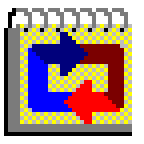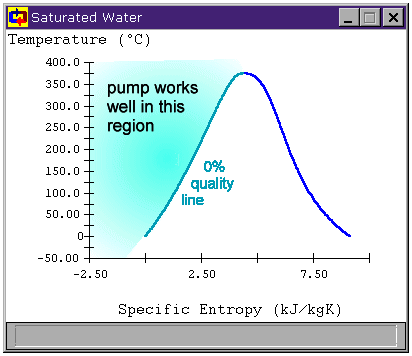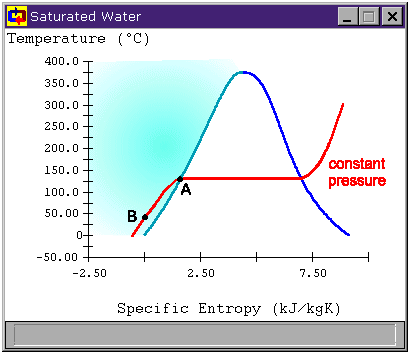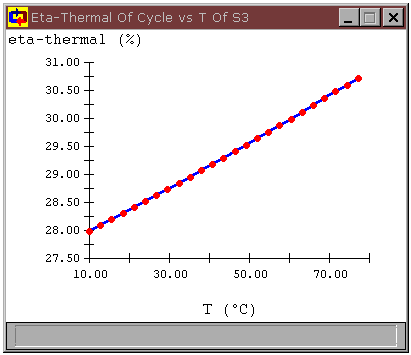
CyclePad
Design Library

 |
CyclePad |
 |
We will look at the ideal pump inlet conditions, then see how variations change the thermal efficiency of a typical cycle.
We can see from the figure that any fluid on or to the left of the saturated liquid line (show in green) is pumpable. This means that we could, at constant pressure, cool the fluid down to the saturated liquid line or somewhere past it into the compressed liquid region. The design question becomes where is the optimal point at which to extract the fluid from the cooler and send it to the pump?
The optimal condition for fluid entering the pump from a cooler in a Rankine cycle is typically saturated liquid and here's why: Removing more heat than is necessary to get the fluid down to the saturated liquid line means rejecting (throwing way) more heat from the fluid while it flows through the cooler. This is heat that we will have to add to the fluid again in the heater, so we don't want to throw away any more of it than necessary. Even when efforts are made to use the heat rejected in the cooler for some other purpose, unless this use is 100% efficient, we are still better off rejecting as little heat as we can in the cooling process. This means cooling right down to the saturated liquid line and not past it.
In addition, if it is possible to cool the working fluid down past the saturated liquid line, there is an extra advantage in removing it earlier in that we can avoid real-world pressure losses in the cooler's tubing and remain closer to our ideal assumption of isobaric cooling.
To illustrate, we could set up a Rankine Cycle which is typical except that its working fluid is cooled with ice down to 10°C, giving it the following properties:
This is not usually a problem for the pump, which can handle compressed liquids without difficulty, but the extra heat that we must add later on can impact the thermal efficiency of the cycle. In CyclePad, we can plot the effect of varying the pump inlet temperature on the cycle efficiency. Figure 3 shows that, the closer we can get the pump inlet temperature to the ideal (saturation) temperature of 81.34°C, the higher the cycle's efficiency. For reference, the ideal Rankine cycle's efficiency at the saturation temperature is 30.91%, nearly a 3% improvement over the efficiency of the initial example.
Download the CyclePad design of the initial (over-cooled to 10°C) Rankine cycle from here. Download the CyclePad design of the fixed Rankine cycle from here. Whalley, P.B. 1992. Basic Engineering Thermodynamics.
Oxford University Press. ISBN: 0-19-856255-1 Contributed by: M. E. BrokowskiThe Pump Inlet Requirements

Figure 1: Safe Fluid Pumping Region

Figure 2: Ideal (A) and Non-Ideal (B) Pump Inlet States
We calculate the thermal efficiency of this cycle to be 27.98%.

Figure 3: Cycle Efficiency vs.Pump Inlet Temperature
CyclePad Design Files
Related Entries
Sources
Initial Entry: 01/11/98
Last Edited: 01/12/98
Last Edited: 11/9/01
For comments or suggestions please contact CyclePad-librarian@cs.northwestern.edu